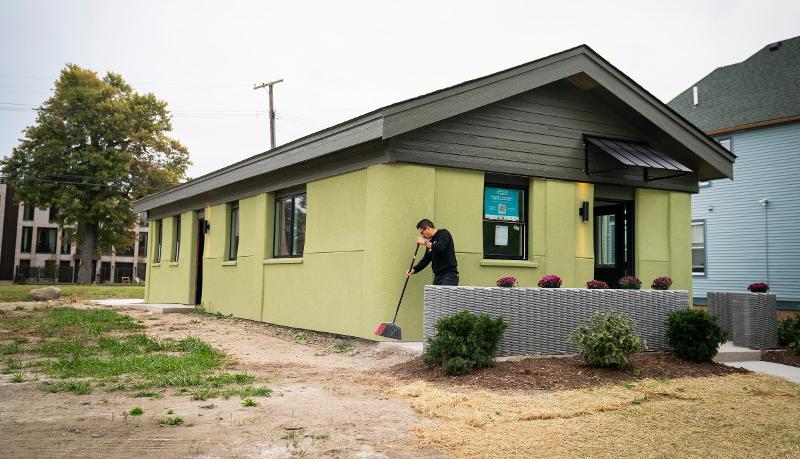Michigan is making history with its first 3D-printed home. In this article, we delve into the fascinating world of 3D printing technology and its impact on the construction industry. Discover the advantages of 3D-printed homes, from cost-effectiveness to energy efficiency, and explore the potential for widespread adoption of this innovative building method.
The Future of Construction: 3D Printing Homes
Discover the groundbreaking technology behind 3D-printed homes and its potential to revolutionize the construction industry.
Traditional construction methods have remained largely unchanged for over a century. However, 3D printing technology is poised to disrupt the industry and usher in a new era of home construction. With the ability to create entire homes using 3D printers, the future of construction is here.
By utilizing 3D printing technology, builders can construct homes faster, more cost-effectively, and with reduced labor requirements. This innovative method of construction holds tremendous potential for addressing housing shortages and improving housing affordability.
The Advantages of 3D-Printed Homes
Explore the numerous benefits of 3D-printed homes, from cost savings to energy efficiency.
One of the major advantages of 3D-printed homes is their cost-effectiveness. While the initial construction costs may be comparable to traditional homes on a smaller scale, the true savings are realized when scaling up production. 3D printing allows for faster construction times, reduced labor requirements, and the use of more sustainable materials.
Furthermore, 3D-printed homes offer significant energy efficiency benefits. These homes can be designed to maximize insulation and reduce energy consumption, resulting in lower utility bills for homeowners. With rising concerns about climate change and the need for sustainable housing solutions, 3D printing technology provides a promising avenue for creating energy-efficient homes.
The Impact on Workforce Development
Discover how 3D printing technology can create new job opportunities and address labor shortages in the construction industry.
As the adoption of 3D printing technology in construction grows, so does the potential for job creation. This innovative building method requires skilled workers to operate and maintain the 3D printers, as well as professionals to design and oversee the construction process. This presents an opportunity for individuals who may not have pursued a traditional four-year degree to enter the construction industry and contribute to the development of 3D-printed homes.
Moreover, 3D printing technology can help address the ongoing labor shortage in the construction industry. With the ability to construct homes faster and with fewer labor requirements, this method offers a solution to the shortage of skilled construction workers. By combining automation with skilled human labor, 3D printing technology can pave the way for a more efficient and productive construction industry.
The Cost Considerations of 3D-Printed Homes
Examine the cost factors involved in 3D-printed home construction and the potential for future cost reductions.
While the initial construction costs of 3D-printed homes may be comparable to traditional homes on a smaller scale, there are several factors that contribute to their long-term affordability. Energy efficiency plays a significant role in reducing monthly utility bills for homeowners, with estimated heating and cooling costs being significantly lower compared to traditionally built homes.
Additionally, as the technology continues to advance and more homes are built using 3D printing, economies of scale are expected to drive down construction costs. With increased efficiency and reduced material waste, the cost of 3D-printed homes is predicted to decrease over time, making them even more accessible to homebuyers.
The Future of 3D-Printed Homes
Explore the potential for widespread adoption of 3D-printed homes and its impact on the housing market.
As the technology behind 3D-printed homes continues to advance and gain traction, the future of construction looks increasingly promising. With its potential for cost savings, energy efficiency, and faster construction times, 3D printing technology is likely to become a mainstream method of home construction.
Moreover, the widespread adoption of 3D-printed homes has the potential to address housing shortages and improve housing affordability. By streamlining the construction process and reducing costs, more individuals and families can have access to quality, affordable homes.
As the construction industry embraces this transformative technology, we can expect to see further advancements and innovations in 3D printing, leading to even more efficient and sustainable homes for the future.
Conclusion
3D printing technology is revolutionizing the construction industry, and Michigan's first 3D-printed home is a testament to its potential. With its cost-effectiveness, energy efficiency, and ability to address labor shortages, 3D-printed homes offer a promising solution to the challenges faced by the housing market.
As the technology continues to advance and become more widely adopted, we can expect to see more affordable and sustainable homes being built using 3D printing. The future of construction is here, and it's an exciting time for both builders and homeowners.
FQA :
Are 3D-printed homes as durable as traditionally built homes?
Yes, 3D-printed homes are designed to be durable and can withstand major storms. The materials used in 3D printing are often stronger than traditional concrete, making these homes resilient and long-lasting.
How long does it take to 3D print a home?
The construction time for a 3D-printed home can vary depending on the size and complexity of the project. However, compared to traditional construction methods, 3D printing offers faster construction times due to its automated nature.
Are 3D-printed homes more expensive than traditional homes?
While the initial construction costs of 3D-printed homes may be comparable to traditional homes on a smaller scale, the long-term affordability and energy efficiency of 3D-printed homes can result in cost savings for homeowners.
Can anyone live in a 3D-printed home?
Absolutely! 3D-printed homes are designed to provide comfortable and sustainable living spaces for individuals and families. They offer an accessible housing option for anyone in need of a quality home.

